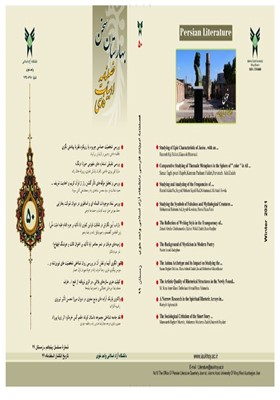Studying of Epic Characteristic of Jarira , with an Approach to the Theory of Intera-texualism ( Based on the Shahnameh of Ferdowsi, Pre-Islamic Texts and the texts of Islamic Era )
Subject Areas : Abstract ArticlesFatemeh Haji Rahimi 1 * , Kianoosh Biranvand 2
1 - PhD Student, Department of Epic Literature, Qom University, Faculty of Literature and Humanities, Qom, Iran.
2 - PhD Student, Department of Epic Language and Literature, Qom University, Faculty of Literature and Humanities, Qom, Iran.
Keywords: Pari, Keywords: intratextual look, Jarira, Siyawash, grand goddess,
Abstract :
Abstract Comprehending any story requires information about its present and past resources. Knowing and better understanding the stories of the Shahnameh won't be possible unless one knows the pre-texts and their relationship to each other. The present research which has been done through qualitative method and by descriptive-analytic approach, deals with the fable of Jarira and the narrative related to it in the Shahnameh. The research is based on the theory which in the stage of transferring the mythological characters to the world of epic, the grand goddess of water and land and fairies ( pari ) in the ancient times lose their characteristics by factors such as the transposition of the myths and fading paradisical color and take the form of Jarira in epic. In these surveys which have been done according to historical evidences, it has been tried to prove that it was these narrators and musicians of the courts of Partians and Kushanians who in the era concurrent with the formulation of epic, in re-narrating the qualities and manners of this ancient mythological character have imposed the desired patriarchal society in regard to humiliating ideas about the women. The traits such as her lower personality in the Shahnameh, her beauty, extra humanistic actions and her love affairs, her reproductivity and ultimately her disappearance organize these tenets.
فهرست منابع و مآخذ
الف: کتب
1- آلن، گراهام، (1385)، بینامتنیت، ترجمۀ پیام یزدانجو، تهران: مرکز.
2- ابن اثیر، عزّالدین، (1391)، تاریخ کامل، برگردان حسین روحانی، تهران: اساطیر. چاپ 2.
3- ابنبلخی، (1363)، فارسنامه، تهران: دنیای کتاب.
4- اسدیطوسی، علی بن احمد، (1382)، گرشاسبنامه، تصحیح حبیب یغمایی، تهران: دنیای کتاب.
5- بلعمی، ابوعلی، (1368)، تاریخ بلعمی، تصحیح ملکالشعرای بهار و محمد پروین گنابادی. تهران: هرمس.
6- بهار، مهرداد، (1376)، از اسطوره تا تاریخ، ویراستار ابوالقاسم اسماعیلپور، تهران: چشمه.
7- ـــــــــــ ، (1381)، پژوهشی در اساطیر ایران، تهران: آگه، چاپ 4.
8- خالقیمطلق، جلال، (1395)، زنان در شاهنامه، تهران: مروارید.
9-__________ ، (1372)، گل رنجهای کهن، به کوشش علی دهباشی، تهران: مرکز.
10- __________، (1386)، یادداشتهای شاهنامه، تهران: مرکز دائره المعارف بزرگ اسلامی.
11- دلاشوا، م. لوفر، (1366)، زبان رمزی قصّههای پریوار، ترجمۀ جلال ستاری، تهران: توس.
12- سرکاراتی، بهمن، (1378)، سایههای شکار شده، گزیدۀ مقالات فارسی، تهران: قطره.
13- سیبرت، ایلسه، (1380)، زن در شرق باستان، ترجمه رقیه بهزادی، تهران: پژوهنده.
14- صفا، ذبیحالله، (1390)، حماسه سرایی در ایران، تهران: فردوس، چاپ 5.
15- طبری، محمّدجریر، (1353)، تاریخ طبری، ترجمۀ ابوالقاسم پاینده، تهران: بنیاد فرهنگ ایران.
16- فردوسی، ابوالقاسم، (1386)، شاهنامه، دفتر 2و3، تهران: مرکز دائرهالمعارف بزرگ اسلامی.
17- کزّازی، میرجلالالدّین، (1382)، نامۀ باستان، ج3، تهران: سمت.
18- کیا، خجسته، (1369)، شاهنامۀ فردوسی و تراژدی آتنی، تهران: علمی و فرهنگی.
19-ــــــــــــــ، (1371)، سخنان سزاوار زنان در شاهنامه، تهران: فاخته.
20- گزنفون، (1342)، کورش نامه، ترجمة رضا مشایخی، تهران: علمی و فرهنگی.
21- مجملالتواریخ والقصص، (1361)، به تصحیح ملک الشّعرای بهار.
22- مختاریان، بهار، (1389)، درآمدی بر ساختار اسطورهای شاهنامه، تهران: آگه.
23- مسعودی، ابوالحسن علی، (1966)، مروّجالذّهب، به کوشش شارل پلّا، ج2، بیروت.
24- نامورمطلق، بهمن، (1390)، درآمدی بر بینامتنینگری: نظریّهها و کاربردها، تهران: سخن.
25- ندا، طه، (1387)، ادبیّات تطبیقی، ترجمة هادی نظری مقدّم، تهران: نی.
26- هینلز، جان راسل، (1379)، شناخت اساطیر ایران، ترجمه باجلان فرخی، تهران: اساطیر.
ب: مجلاّت و نشریات
27 - آیدنلو، سجّاد، (1385)، ارتباط اسطوره و حماسه برپایۀ شاهنامه و منابع ایرانی، مجلّۀ مطالعات ایرانی، شمارۀ پیاپی10، صص: 28-49.
28- ـــــــــــــ ، (1384)، فرضیهای دربارۀ مادر سیاوش، نامۀ فرهنگستان، دورۀ 7، شمارۀ 27، صص: 46-27.
29- عبّاسی، حجّت، قبادی، حسینعلی، (1389)، مقایسۀ جایگاه زن در شاهنامۀ فردوسی با ایلیاد و اودیسۀ هومر، فصلنامۀ ادبیات عرفانی و اسطوره شناختی، دورۀ 6، شمارۀ 19، صص: 138-109.
33- Genette. Gerard. Palimpsests: Literature in second Degree, Trans: Channanewman and Calude Doubinsky, Linkoln: University of Nebraska.(1977)HD
_||_
